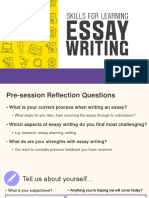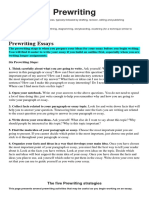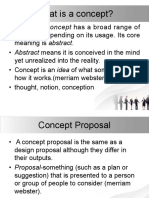0 ratings0% found this document useful (0 votes)
4 viewsnull-18
Effective prewriting techniques help writers create, develop, and organize their ideas before drafting. Key strategies include brainstorming, understanding the assignment's purpose, and considering the audience and format. Writing prompts provide structured guidance, outlining the topic, audience, task, format, and any special requirements for the writing response.
Uploaded by
khaledalaa974Copyright
© © All Rights Reserved
Available Formats
Download as PDF, TXT or read online on Scribd
0 ratings0% found this document useful (0 votes)
4 viewsnull-18
Effective prewriting techniques help writers create, develop, and organize their ideas before drafting. Key strategies include brainstorming, understanding the assignment's purpose, and considering the audience and format. Writing prompts provide structured guidance, outlining the topic, audience, task, format, and any special requirements for the writing response.
Uploaded by
khaledalaa974Copyright
© © All Rights Reserved
Available Formats
Download as PDF, TXT or read online on Scribd
You are on page 1/ 19
EFFECTIVE PREWRITING TECHNIQUES
Prewriting is any activity that helps you
create, develop, and organize ideas for
writing.
WHY BOTHER WITH PREWRITING?
• To find a definite direction for your
writing assignment
• To help organize your
ideas before trying to write your first
draft
• To build off of ideas and think of new
ones
QUESTIONS TO ASK YOURSELF
WHEN BEGINNING A WRITING
ASSIGNMENT
• Were you given a topic, or can you
choose one?
• What is the purpose of this
assignment? Are you informing,
persuading, analyzing, entertaining,
or summarizing for your readers?
• What are the five W’s of the
assignment? Who? What? When?
Where? Why?
BRAINSTORMING
Brainstorming is a technique where you
record every idea that comes to mind
that relates back to the topic.
HELPFUL HINTS
• Be comfortable and in a space with
good lighting. You’ll think best when
you’re in a pleasant environment.
• Eliminate distractions. Stay focused
and record everything.
• Make lists of all the ideas that come to
you. Don’t worry about trying to write in
complete sentences. Just capture your
ideas quickly.
• Brainstorm by having conversations with
other people. Bounce ideas off of a
friend, or raise a topic of conversation
with a group of people.
• Brainstorming can make it easier both
to think of a good topic and to start
finding supporting evidence and
examples.
What Are Writing Prompts?
A writing prompt is direction to write
about a particular topic. This may be
presented in one or more sentences, or
it may include a short passage, picture,
or other content that serves as a
starting point for the written response.
A well-constructed writing prompt can
provide students important guidance for
showcasing the writing skills they have
been taught.
Generally, writing prompts include five
components: 1. Topic: on what the response
should focus 2. Audience: to whom the
response should be addressed 3. Task: how
information on the topic should be organized
(e.g., description, sequence, compare-
contrast, analysis, synthesis, cause-effect,
explanation) 4. Format: the style of writing
of writing for the response (e.g., essay,
argument, speech, letter, narrative) 5.
Special requirements: additional
expectations for the prompt (e.g., length,
textual evidence, number of supports, kinds
of details)
You might also like
- The Writing Process: Saleem Khan 25 March 2016No ratings yetThe Writing Process: Saleem Khan 25 March 201632 pages
- Thewritingprocess 111029202250 Phpapp01No ratings yetThewritingprocess 111029202250 Phpapp0124 pages
- Preparing and Writing A Dissertation: A Model To Criticise!No ratings yetPreparing and Writing A Dissertation: A Model To Criticise!6 pages
- Extended Project: Writing Up Your ResearchNo ratings yetExtended Project: Writing Up Your Research11 pages
- Techniques in Selecting and Organizing Information CopyNo ratings yetTechniques in Selecting and Organizing Information Copy59 pages
- Thesis Writing: Dr. Tamara O'Connor Dr. Mark Matthews100% (1)Thesis Writing: Dr. Tamara O'Connor Dr. Mark Matthews38 pages
- Orca Share Media1699427701894 7127916407768776920No ratings yetOrca Share Media1699427701894 712791640776877692033 pages
- Reflective Writing: The Learning Centre - HTTP://WWW - Lc.unsw - Edu.auNo ratings yetReflective Writing: The Learning Centre - HTTP://WWW - Lc.unsw - Edu.au4 pages
- Week 001-Course Module-Writing StrategiesNo ratings yetWeek 001-Course Module-Writing Strategies4 pages
- Stages of The Writing Process: Prewriting: Prewriting Is Everything You Do Before You Begin To Draft The Paper. Look Over An Assignment HandoutNo ratings yetStages of The Writing Process: Prewriting: Prewriting Is Everything You Do Before You Begin To Draft The Paper. Look Over An Assignment Handout2 pages
- Writing A Humanities Dissertation Part 1No ratings yetWriting A Humanities Dissertation Part 161 pages
- Open Book Review: English 2: Submitted ToNo ratings yetOpen Book Review: English 2: Submitted To6 pages
- Academic Writing Guide: By: Egi Evanda Gita Pahdila Metha Fadhila Winda Agustrianti Yosse FirdausNo ratings yetAcademic Writing Guide: By: Egi Evanda Gita Pahdila Metha Fadhila Winda Agustrianti Yosse Firdaus19 pages
- Session 1 Beginnings and Endings - Giving Your OpinionNo ratings yetSession 1 Beginnings and Endings - Giving Your Opinion13 pages
- The Student’s Guide to Writing: Essential Outlines and StrategiesFrom EverandThe Student’s Guide to Writing: Essential Outlines and StrategiesNo ratings yet
- Preparing and Writing A Dissertation: A Model To Criticise!Preparing and Writing A Dissertation: A Model To Criticise!
- Techniques in Selecting and Organizing Information CopyTechniques in Selecting and Organizing Information Copy
- Thesis Writing: Dr. Tamara O'Connor Dr. Mark MatthewsThesis Writing: Dr. Tamara O'Connor Dr. Mark Matthews
- Reflective Writing: The Learning Centre - HTTP://WWW - Lc.unsw - Edu.auReflective Writing: The Learning Centre - HTTP://WWW - Lc.unsw - Edu.au
- Stages of The Writing Process: Prewriting: Prewriting Is Everything You Do Before You Begin To Draft The Paper. Look Over An Assignment HandoutStages of The Writing Process: Prewriting: Prewriting Is Everything You Do Before You Begin To Draft The Paper. Look Over An Assignment Handout
- Academic Writing Guide: By: Egi Evanda Gita Pahdila Metha Fadhila Winda Agustrianti Yosse FirdausAcademic Writing Guide: By: Egi Evanda Gita Pahdila Metha Fadhila Winda Agustrianti Yosse Firdaus
- Session 1 Beginnings and Endings - Giving Your OpinionSession 1 Beginnings and Endings - Giving Your Opinion
- The Student’s Guide to Writing: Essential Outlines and StrategiesFrom EverandThe Student’s Guide to Writing: Essential Outlines and Strategies



























































